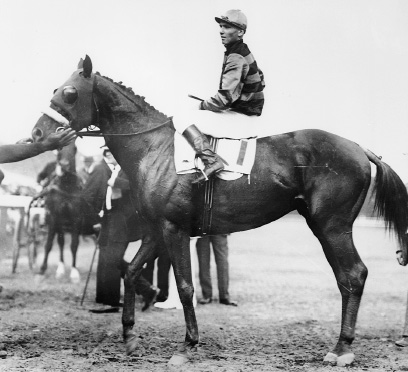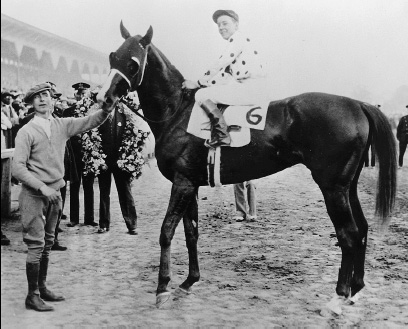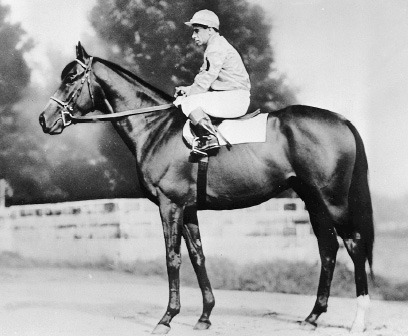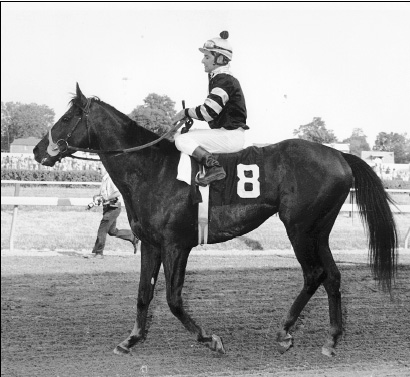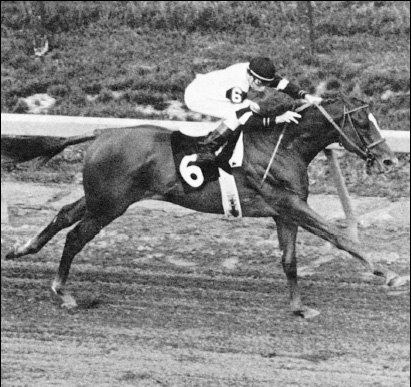Triple Crown Winners

It is no longer necessary to prove that the Triple Crown is the most elusive prize in sports. It has been 32 years since Affirmed, the latest of eleven Thoroughbreds in history, achieved the prestigious feat in 1978. There have been but three Triple Crown winners since Citation in 1948.
There was one spell, a quarter of a century, from Citation in 1948 until 1973, that brought talk of tinkering with the scheduling or devising some sort of relief to make the Triple Crown more accessible because it seemed it would never again be won. Then Secretariat came along and romped through the Derby, Preakness and Belmont in 1973.
When Funny Cide lost the potential Triple Crown at the 2003 Belmont Stakes, a new time elapsed record was set. Six times in the last eight years a horse has gone to New York with a chance at a $5 million dollar bonus only to falter in the "Test of a Champion".
The intriguing series of spring races is over 125 years old with the prize becoming available in 1875, with the first running of the Kentucky Derby, the last of the Triple Crown events to be introduced. The Preakness dates back to 1873, while the Belmont Stakes began in 1867.
|
|
|
|
Johnny Loftus, rider |
Sir Barton
First Triple Crown Winner, 1919 Chestnut colt, 1916 by *Star Shoot-Lady Sterling, by Hanover J. K. L. Ross, Owner Madden and Gooch, Breeder M. G. Bedwell, Trainer A Genuine Iron Horse |
Sir
Barton, a foal of 1916 bred by Preston Madden, was born too
soon. He was never hailed as a Triple Crown winner because
the feat had not been named when he swept the Derby, Commander J. K. L. Ross, who owned a farm in Maryland where the former Freestate harness track was located, purchased Sir Barton for $10,000 as a 2-year-old at Saratoga. Ross had an outstanding 3-year-old prospect in 1919 - Billy Kelly - but Sir Barton, his stablemate, who had never won a race, was started in the Derby as part of the Ross entry. Sir Barton broke on top in the Derby and never looked back. Perhaps more amazing, Sir Barton was immediately shipped to Pimlico because that year the Maryland classic was run on Wednesday, just four days after the Derby. Once again the unheralded Sir Barton galloped home by four lengths in a display of stamina. In the Belmont, he set an American record of 2:17 2/5 for the mile and three-eighths, the distance then. |
|
|
|
|
|
Gallant Fox
Second Triple Crown Winner, 1930 Bay colt, 1927 by *Sir Gallahad III-Marguerite, by Celt Belair Stud, Owner-Breeder James Fitzsimmons, Trainer Fox of Belair |
Earle Sande, rider Keeneland-Cook Photo |
| Gallant Fox was
bred and raced by William Woodward.
The son of Sir Gallahad III had a medicore 2-year-old season winning but two stakes. It was hardly an indication of his 3-yearold superiority. After capturing the Wood Memorial, Gallant Fox swept the Preakness, Kentucky Derby and Belmont Stakes in that order. He is the only Triple Crown winner to win the Preakness week before the Derby. Later as a 3-year-old he captured the Dwyer Stakes, Arlington Classic, Saratoga Cup, Lawrence Realization and the Jockey Club Gold Cup. The "Fox of Belair" was retired for breeding after his 3-year-old campaign, which netted $308,275, a single season record then. Gallant Fox sired the
winners of more than ninety races before his death in 1954
at the age of 27. His most famous son was Omaha, the 1935
Triple Crown winner. Omaha enabled him to become the only
Triple Crown winner to sire a victor in the |
|
|
|
|
|
Omaha
Third Triple Crown Winner, 1935 Chestnut colt, 1932, by Gallant Fox-Flambino, by *Wrack Belair Stud, Owner-Breeder James Fitzsimmons, Trainer Like Father, Like Son |
Willie Saunders, rider Bert Morgan Photo |
| Omaha was born
in Kentucky in 1932, just two years after his sire, Gallant Fox, had won the Triple Crown. As a weanling, he was sent to Belair in Maryland where he was broken as a yearling and turned over to trainer Sunny Jim Fitzsimmons. The William Woodward owned and bred colt, like his sire, was not overly impressive at two but improved with age. After a third in the Wood Memorial, he set sail for the Triple Crown. Nellie Flag, a filly, was favored in the Derby but Omaha rallied and won by a length and a half. The Preakness was more of a romp as he won by six lengths. He became the third Triple Crown winner with a length and a half victory in the Belmont. Omaha is the only Triple Crown winner to race abroad. Woodward sent him to England at four. After taking two secondary stakes, Omaha just missed winning the Ascot Gold Cup. |
|
|
|
|
|
Charles Kurtsinger, rider C. C. Cook Photo |
War Admiral
Fourth Triple Crown Winner, 1937 Brown colt, 1934, by Man o' War-Brushup, by Sweep Glen Riddle Farm, Owner S. D. Riddle, Breeder George Conway, Trainer Little Admiral |
| War Admiral was
a smaller copy of his illustrious sire, Man War. Although he
stood only 15.2 hands, War Admiral was Man War's best
offspring. Owned and bred by Sam Riddle, who Man O' War, War
Admiral reached his peak as a 3-year-old so-so 2-year-old
season. At three, War
Admiral, who prepped in Maryland for the In the Derby, War Admiral
led from flag to finish, but The Belmont Stakes proved to be War Admiral's easiest victory in the Triple Crown despite his stumbling at the start. fall of 1937, War Admiral won the first Pimlico Special and named Horse of the Year. In all, War Admiral won 21
of 26 starts and finished out |
|
|
|
|
|
Eddie Arcaro, rider Bert Morgan Photo |
Whirlaway
Fifth Triple Crown Winner, 1941 Chestnut colt, 1938, by *Blenheim II-Dustwhirl, by Sweep Calumet Farm, Owner-Breeder B. A. Jones, Trainer Calumet Star In '41 |
| Once Trainer
Ben Jones solved Whirlaway's bewildering habit of running
extremely wide on the turns, there was no stopping the
Calumet colt sired by Blenheim II. Jones devised a special
blinker for the chestnut colt just in time for the 1941
Kentucky Derby. With Eddie Arcaro riding, Whirlaway made a dramatic stretch run at Churchill Downs to set a new time record as he ran the mile and a quarter in 2.01 2/5 and won by eight lengths. A week later, Whirlaway
again came from far back to Whirlaway, who won five
other stakes in addition to the |
|
|
|
|
|
Count Fleet
Sixth Triple Crown Winner, 1943 Brown colt, 1940, by Reigh Count-Quickly, by Haste Mrs. John D. Hertz, Breeder-Owner D. J. Cameron, Trainer Speed to Spare |
Johnny Longden, rider Bert Clark Thayer Photo |
| Count Fleet
shot like a meteor across the racing stage when World War II
was raging in 1942 and 1943. After winning ten of fifteen
starts as a 2-year-old, he was all but conceded the Triple
Crown after being complimented with 132 pounds in the
Experimental Handicap ratings. A son of Reigh Count, the 1928 Derby winner, and foaled by Quickly by Haste, Count Fleet carried the colors of Mrs. John D. Hertz, wife of the Chicago taxicab executive. A striking brown colt, Count Fleet was hailed as a successor to Man O' War by some after his perfect six for six 3-year-old season. The war-time ban on racing in Florida forced Count Fleet to train at Oaklawn Park in preparation for his 3-year-old campaign. In the Triple Crown, Count Fleet, with Johnny Longden riding, found little opposition. He galloped in the Derby, captured the Preakness with only three challengers by eight lengths, and then, after taking the Withers, annexed the Triple Crown with a 25-length triumph in the Belmont Stakes. |
|
|
|
|
|
Assault
Seventh Triple Crown Winner, 1946 Chestnut colt, 1943, by Bold Venture-Igual, by Equipoise King Ranch, Owner-Breeder M. Hirsch, Trainer Surprise in 1946 |
Warren Mehrtens, rider Bert Morgan Photo |
| Assault, the
seventh Triple Crown winner, overcame long odds against his
feet in 1946. To start with, his dam, Iqual, sired by Equipoise, never raced. She was sickly as a foal and never recovered sufficiently to stand the rigors of training. Her first two foals were not notable. Her third, Assault, sired by Bold Venture, the 1936 Derby winner, had the misfortune to step on a surveyor's stake at the King Ranch in Texas where he was born. The hoof healed but Assault had a tendency to favor the foot, making it appear that he was crippled. His trainer, Max Hirsch, at first thought the colt would not train because of his crooked foot. Assault was not impressive at two, winning only two races. Even after taking the Experimental Handicap and Wood Memorial at three, he went off at 8-1 odds in the Derby. Favored in the Preakness, Assault won by a neck, after holding a four length advantage with an eighth mile to go. Then jockey Warren Mehrtens changed his tactics in the Belmont, reserving the colt and charging from behind to win by three lengths. |
|
|
|
|
|
Eddie Arcaro, rider NYRA Photo |
Citation
Eighth Triple Crown Winner, 1948 Bay colt, 1945, by Bull Lea-*Hydroplane II, by Hyperion Calumet Farm, Breeder-Owner H. A. Jones, Trainer Racing's First Millionaire |
| Citation, from
Calumet Farm, capped the glorious '40's decade - the most glamorous in Triple Crown lore as four horses attained sport's most elusive prize.
There is little argument that
the bay colt by Bull Lea - Big Cy, although bred in Kentucky by Warren Wright, made his debut in Maryland, winning his first start at Havre de Grace in 1947. Later that year he captured the Pimlico Futurity on his way to an 8 for 9 year at two. As a 3-year-old, Citation went 19 for 20. His only loss occurred at Havre de Grace in a sprint race he should not have lost. He was carried wide by a tiring horse and finished second to Saggy in the Chesapeake Trial. The Triple Crown was hardly
a challenge for Citation. |
|
|
|
|
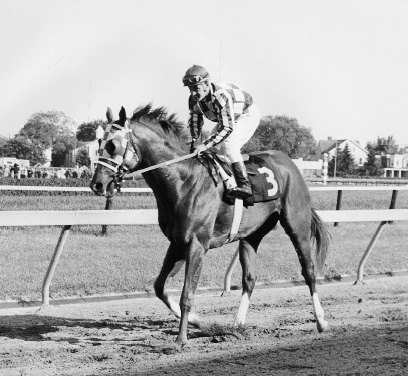 Ron Turcotte, rider Maryland Jockey Club Photo |
Secretariat
Ninth Triple Crown Winner, 1973 Chestnut colt, 1970, by Bold Ruler-Somethingroyal, by *Princequillo Meadow Stable, Breeder-Owner Lucien Laurin, Trainer After 25 Years-Secretariat |
| Secretariat,
often described as the perfect horse in appearance with his
resplendent chestnut coat, might have been horse racing's
greatest ambassador of the 20th century. The massive
Virginia-bred colt from the Meadow Stable of Helen "Penny"
Chenery, made a shambles of the Triple Crown in 1973. Before he was nominated for the Triple Crown, Secretariat recorded a first - the first 2-year-old ever to be voted Horse of the Year. The son of Bold Ruler-Somethingroyal was a full-fledged celebrity well in advance of his Triple Crown heroics, having been syndicated for a then record $6,080,000 early in his 3-year old season. In the Kentucky Derby, he set a record for the mile and a quarter, running the distance in 1.59-2/5. In a powerful move from last on the clubhouse turn, Secretariat captured the Preakness with ease. In the Belmont Stakes, Secretariat put on an awesome show, winning by 31 lengths to gain the Triple Crown, a prize which had gone unclaimed for a quarter of a century. |
|
|
|
|
|
Seattle Slew
Tenth Triple Crown Winner, 1977 Dark brown colt, 1974, by Bold Reasoning-My Charmer, by Poker Mrs. Karen Taylor, Owner Ben S. Castleman, Breeder William H. Turner, Trainer Bargain Buy |
Jean Cruguet, rider Maryland Jockey Club Photo |
| Seattle Slew
holds an unique Triple Crown record. The grandson of Bold Ruler is the only Thoroughbred in history to capture the Triple Crown with an unbeaten record. After the Triple Crown, Seattle Slew lost only three of seventeen career starts on his way to total earnings of $1,208,727. Bred in Kentucky by Ben S. Castleman, Seattle Slew was purchased at the bargain price of $17,500 at a Kentucky yearling auction by Mickey Taylor for his wife Karen, in whose silks the son of Bold Reasoning raced. Veterinarian Dr. James Hill and his wife Sally shared ownership of Seattle Slew. It was Hill who had recommended the purchase of the colt. Seattle Slew was named the 2-year-old champion in 1976 and Horse of the Year as well as the top 3-year-old in 1977. William H. "Billy" Turner, Jr., a former steeplechase rider from Monkton, Md. was only 37 when he trained Seattle Slew to his 2- and 3-year-old championships. Seattle Slew was retired for breeding in 1979 after being syndicated for $12 million. |
|
|
|
|
|
Affirmed
Eleventh Triple Crown Winner, 1978 Chestnut colt, 1975, by Exclusive Native-Won't Tell You, by Crafty Admiral Harbor View Farm, Owner-Breeder Lazaro S. Barrera, Trainer Toughest Triple Crown |
Steve Cauthen, rider Maryland Jockey Club Photo |
| Affirmed
became the last Triple Crown winner in 1978 and it was not
easy. Affirmed's combined margin of victory in the Triple
Crown was less than two lengths - 11/2 lengths in the Derby,
a neck in the Preakness and a head in the Belmont.
Amazingly, each time it was Alydar, battling him to the
wire. The Florida-bred colt - the first from that state to
win the Triple Crown - raced for the Harbor View Farm of Mr.
and Mrs. Louis Wolfson. Affirmed won 22 of his 29 career starts, earning $2,393,818. The chestnut son of Exclusive Native, was named Horse of the Year twice as well as 3-year-old champion in 1978. As a 4-year-old he captured seven stakes and beat out Spectacular Bid for Horse of the Year honors. After his 4-year-old campaign he was retired to Spendthrift Farm and syndicated for $14.4 million. |
|


